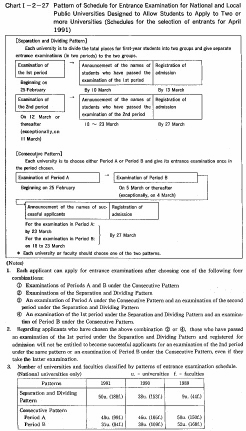| Home > Policy > White Paper, Notice, Announcement > White Paper > JAPAMESE GOVERNMENT POLICIES IN EDUCATION,SCIENCE AND CULTURE 1990 > PART |
||
In order to allow students to apply to two or more national
or local public universities, a "Consecutive Pattern" was introduced for the
selection of university entrants for April 1987. (According to this pattern,
each university is to choose a single period from among two periods (period A
and period B) for the period of its own entrance examination. Each university
will give its entrance examination to all applicants only once a year.) In addition
to this pattern, a "Separation and Dividing Pattern" was introduced for the selection
of university entrants for April 1989. (Under this pattern, each university is
to administer its own entrance examination twice a year, dividing all entrant
places into two groups: one to be selected through the first-period entrance
examination, and the other to be selected through the second-period entrance
examination.) (See Chart ![]() -2-27.)
-2-27.)

For the selection of the 1989 entrants to national universities, 44 faculties at nine universities adopted the "Separation and Dividing Pattern," while for the selection of the 1991 entrants, the number of institutions which adopted this pattern increased to 188 faculties at 50 universities, accounting for more than 50% of all faculties and of all national universities, respectively.
This substantial increase in the number of universities adopting the "Separation and Dividing Pattern" has been positively appraised because of the following reasons: (1) this pattern of entrance examination will contribute to avoiding the revival of the ranking of universities which tended to be prevalent during the years when the national universities were classified into two groups according to the dates of entrance examination; (2) each university can recruit diverse students with diverse qualities by providing two separate entrance examinations based on different criteria of assessment. This practice will also contribute to the vitalization of each university: (3) each university will be able to obtain relevant data useful for the further improvement of its entrance examination, by conducting follow-up studies of the academic performance of students admitted to the university on the basis of the different criteria of assessment; (4) since this pattern allows little room for an additional number of students to be admitted or for an additional recruitment of applicants (to be caused by a shortage of successful applicants), few applicants will be obliged to wait uneasily for the final announcement of the university. This pattern is expected to lead to increased opportunities for students to choose their university and to contribute to the introduction of diverse selection methods.
| Back to Top | MEXT HOME |